Keren Joy T. Compelio, Lawrence C. Caranto, Juan Jose T. David
College of Nursing, Benguet State University, La Trinidad, Benguet, Philippines
Correspondence to: Keren Joy T. Compelio, College of Nursing, Benguet State University, La Trinidad, Benguet, Philippines.
| Email: |  |
Copyright © 2015 Scientific & Academic Publishing. All Rights Reserved.
Abstract
This article is a report on a study conducted to determine the awareness, understanding, and acceptance of the vision and mission of Benguet State University (BSU) and the goals and objectives of the College of Nursing (CN). Specifically, it sought to: determine the difference in the awareness, understanding, and acceptance of the VMGO according to year level and sex; examine the correlation between the awareness, understanding, and acceptance of the students towards the VMGO; and, identify the means by which the students contribute to the attainment of the VMGO. The results of the study provide an insight to the awareness, understanding, and acceptance of the students of the VMGO of the university. The outcome may be beneficial in generating information for the enhancement of the practices of the College of Nursing as well as other institutions in the dissemination and evaluation of their VMGO. The results revealed that the students of Benguet State University – College of Nursing generally have high awareness and understanding and very high acceptance of the VMGO. The higher the year level of the students, the more aware, understanding, and accepting they are. Sex on the other hand is a contributing factor; notably, males are more aware and accepting of the VMGO. The study further underscored that there is a correlation among the awareness, understanding, and acceptance of the VMGO by the students. Meanwhile, the means by which the students contribute to the attainment of the VMGO distinctly include complying with the rules and policies of the university, striving for academic excellence, participating actively in school activities, becoming a role model, passing the board exams, and conducting research. Anchored on the conclusions of the study, the following recommendations were derived: the University and the College concerned should continuously work for the awareness, understanding, and acceptance of its vision, mission, goals, and objectives; opportunities for VMGO orientation be designed to increase awareness, understanding, and acceptance especially among newly enrolled students regardless of the educational program; educational activities of the university be undertaken for the realization of the goals and objectives; assessment on the awareness, understanding, and acceptance of the VMGO by the students be done periodically; and, finally, future research undertakings be conducted similar to the study involving other institutions.
Keywords:
Vision, mission, Goals, and objectives (VMGO), Awareness, Understanding, and acceptance, Student nurses
Cite this paper: Keren Joy T. Compelio, Lawrence C. Caranto, Juan Jose T. David, Awareness, Understanding, and Acceptance of Student Nurses of the Vision, Mission, Goals, and Objectives of Benguet State University, International Journal of Nursing Science, Vol. 5 No. 1, 2015, pp. 20-27. doi: 10.5923/j.nursing.20150501.03.
1. Introduction
The vision, mission, goals, and objectives (VMGO) serve as the cornerstone of an educational institution. It is the first and the primary area that is examined in times of accreditation. Robbins, Coulter, and Stuart-Kotze [1] (2003) account that the VMGO statements are the fundamental guides for the future of the institution and its academic programs. They define collective efforts and align the whole organization towards the accomplishment of programs and activities. The vision and mission are statements on the long-term view of the institution of itself and of the world within which it operates, including the fundamental purpose of its existence, its long-term role and stature, and what it does to achieve this purpose and how it would like to play its role. The program educational objectives are broad statements that describe the career and professional accomplishments that the program is preparing graduates to achieve within three to five years of graduation. These objectives are based on the needs of the program’s constituencies (CMO No. 37, 2012) [2].An educational program is recognized by the Accrediting Agency for Chartered Colleges and Universities in the Philippines (AACCUP) as possessing certain standards of quality and excellence based on the institution’s educational operations in relation to its VMGO. A university is judged by the degree to which its VMGOs are attained, not in comparison to others (AACCUP, 2010) [3].The effectiveness of the VMGO lies in its structure and dissemination. In order to be attained, the constituents of an educational institution have to be aware of its VMGOs and fully comprehend the implications of such.Numerous studies regarding the VMGO have been conducted in recent years. A study has shown that the students of a university are aware of its vision, mission, goals, and objectives and that these students understand and accept these statements, along with the responsibility of realizing such objectives in their own capacities (Castillo, 2014) [4]. Another study has similarly concluded that the constituents of a university are aware and keen in knowing the importance of the core principles contained in their VMGOs (Salom & Florendo, 2013) [5]. The aim of this study is to investigate the awareness, understanding, and acceptance of the vision and mission of Benguet State University (BSU) and the goals and objectives of the College of Nursing (CN). Specifically, it sought to: determine the difference in the awareness, understanding, and acceptance of the VMGO according to year level and sex; examine the correlation between the awareness, understanding, and acceptance of the students towards the VMGO; and, identify the means by which the students contribute to the attainment of the VMGO. The paradigm of the study is presented in the following figure: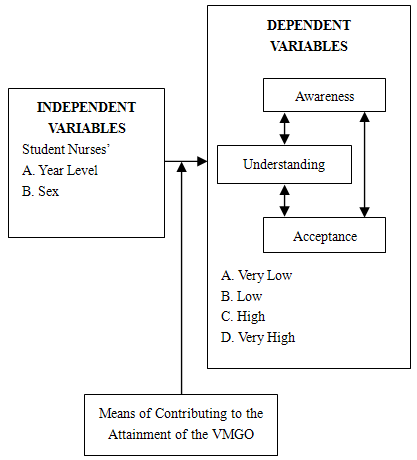 | Figure 1. The Relationship of Awareness, Understanding, and Acceptance of Student Nurses |
The results of the study provide an insight to the awareness, understanding, and acceptance of the students of the vision, mission, goals, and objective of BSU. The outcome may be beneficial in generating information for the enhancement of the practices of the College of Nursing as well as other colleges and institutions in the dissemination and evaluation of their VMGO.
2. Methods
2.1. Design
The study employed the mixed method research design which involves the quantitative-descriptive and the qualitative-descriptive designs.
2.2. Sampling
The students of BSU – CN were taken as respondents and participants upon their approval. For the quantitative data, total enumeration was used. Meanwhile, comprehensive purposive sampling was utilized for the qualitative data in which 40 students were interviewed.
2.3. Instrument
Semi-structured interviews and focus group discussions were conducted. The interviews covered the students’ level of awareness, understanding, and acceptance of the BSU vision and mission and the CN goals and objectives, and their means of contributing to the attainment of such. To attain a reliable assessment of the variables, a four-point Likert scale was utilized. Distinctly, the data were collected over a week period in November 2014.
2.4. Statistical Treatment
Statistical analyses were undertaken using SPSS software, version 21 (SPSS Inc., Chicago, IL, USA). Appropriate statistical tools were employed in the data analyses. In particular, weighted mean was used to determine the awareness of the students, analyze their understanding, and assess their acceptance of the VMGO. T-test on the other hand was utilized to determine the differences on the responses of students when grouped according to sex. With reference to year level, the Tukey’s Honest Significant Difference test was employed especially appealing to multiple comparisons. Pearson Correlation was used to determine the correlation between the awareness, understanding, and acceptance of the students towards the VMGO.
2.5. Data Analysis
The statements of the students with regard to how they contribute were written verbatim and were analyzed using the following methods: reading and rereading the responses, extracting significant statements, formulating meanings and categorizing into clusters of themes, and validating to identify the means common to all students with original text.The participants for the qualitative data were grouped according to their year level and sex. To facilitate the grouping, they were categorized as follows: A and B; C and D; E and F; and, G and H – the previous symbols standing for the female and the latter for the male participants while having each pair represent levels IV, III, II, and I, respectively.
3. Results and Discussion
3.1. Level of Awareness, Understanding, and Acceptance of the VMGO
Table 1 underscores that students from Level I and II have high awareness of the VMGO of the university, in contrast with those from Level III and IV having very high awareness. In general, the students revealed high awareness of the VMGO.Table 1. Level of Awareness, Understanding, and Acceptance of the VMGO
 |
| |
|
The results further reveal that Level I and II students highly understand the VMGO of BSU. Level III and IV students on the other hand have very high comprehension of these statements. Similarly, the students have high understanding of the VMGO.As regards acceptance, the freshmen and sophomore students highly accept the VMGO, while the juniors and the seniors very highly accept such. Generally, the students have very high acceptance of the statements.
3.2. Level of Awareness, Understanding, and Acceptance of the Male and Female Students
Table 2 accounts that the females are highly aware of the VMGO, while the males are very highly aware. Generally, the students have high awareness. Meanwhile, T-test shows that the difference in the awareness of the male and female students is significant.Table 2. Awareness, Understanding, and Acceptance of the Male and Female Student Nurses
 |
| |
|
The findings indicate that both the male and the female students have high understanding of the VMGO. However, their understanding differs significantly, as seen in the table.It was also found that both the male and the female students have very high acceptance towards the VMGO. Although the T-test revealed that there is a significant difference between the acceptance anchored on the variable.
3.3. Difference among the Awareness, Understanding, and Acceptance of the Different Year Levels
As gleaned, Table 3 presents no significant difference between Level I and Level II students’ awareness, understanding, and acceptance of the VMGO. Table 3. Multiple Comparison on the Awareness, Understanding, and Acceptance of the Different Year Levels towards the VMGOs
 |
| |
|
 | Figure 2. Means of Student Nurses in Contributing to the Attainment of the VMGO |
Compared to Level III and Level IV, the awareness, understanding, and acceptance of Level I and II significantly differ.Notably, there is a significant difference between the awareness of Level III and Level IV; yet recorded no difference with regard to understanding and acceptance.
3.4. Correlation among the Awareness, Understanding, and Acceptance of the VMGO
Table 4 underscores that the awareness of the students is significantly correlated to their understanding and acceptance of the VMGO. In the same way, there is a correlation between the students’ understanding and their acceptance. Conversely, the acceptance of the students is significantly related to their awareness and understanding of the statements.Table 4. Correlation among the Awareness, Understanding, and Acceptance of Student Nurses
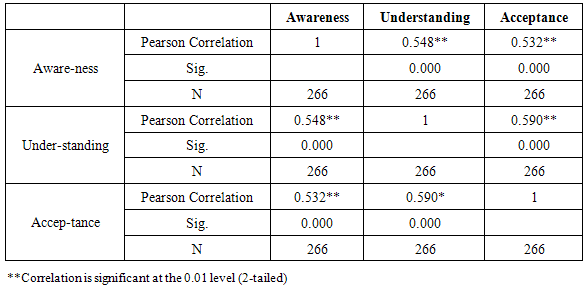 |
| |
|
3.5. Means of Student Nurses in Contributing to the Attainment of the VMGO
The themes that emerged from the data are presented in the conceptual map on the succeeding page. The conceptual map shows six domains.
3.5.1. Compliance with the Rules and Policies of the University
The participants believe that one of their responsibilities as students is to abide by the rules and regulations imposed by the university. This includes being good students, doing their responsibilities, and wearing their uniforms with pride and dignity. Moreover, the participants have said that refraining from violating any of the rules and regulations is their best contribution for the university. They believe that abiding by the policies of the university would aid it in its pursuit of attaining its vision, mission, goals, and objectives.
3.5.2. Striving for Academic Excellence
Most of the participants believe that their greatest contribution for the attainment of the university’s vision and mission and the goals and objectives of the college is to improve their academic standing. Table 5. Compliance with the Rules and Policies of the University
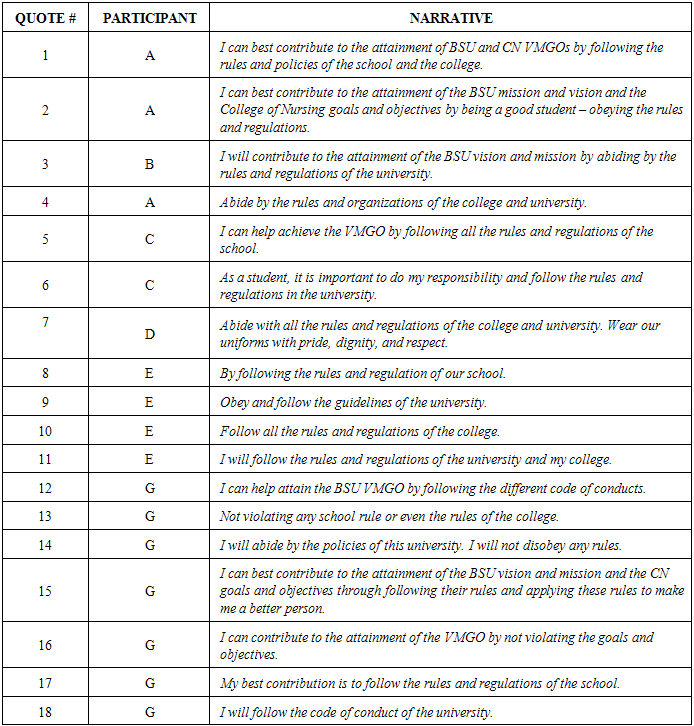 |
| |
|
Table 6. Striving for Academic Excellence
 |
| |
|
Table 7. Active Participation in School Activities
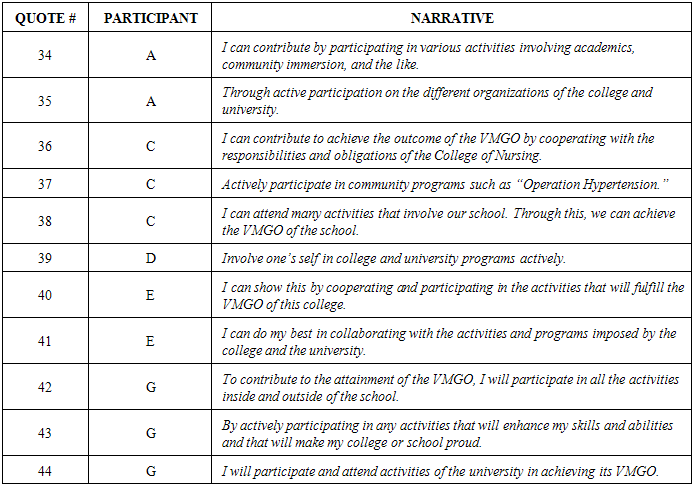 |
| |
|
Table 8. Role Modeling
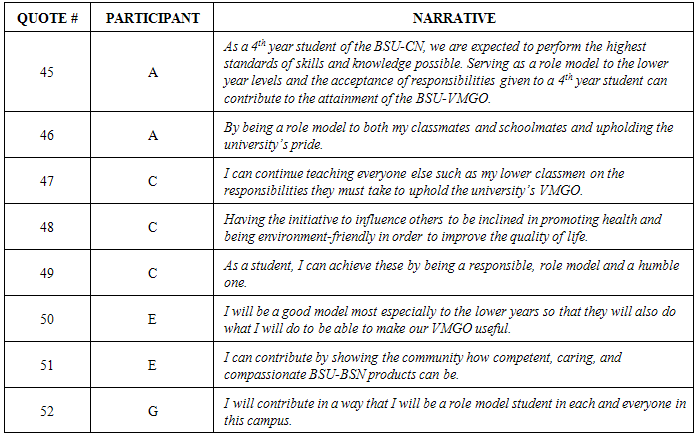 |
| |
|
As students representing the university, they believe that it is expected of them to be responsible in their academics and display competence in their field.
3.5.3. Active Participation
One of the means that the participants perceive as a way to contribute to the attainment of the VMGO is to take part in the activities of the university and/or the College, such as the extension activities and other programs within the institution.
3.5.4. Role Modeling
The respondents believe that by embodying the principles of the university’s VMGO and serving as role models to other students, the vision, mission, goals, and objectives of BSU may be realized. As students of the university, the participants believe that it is expected of them to demonstrate proficiency in their field and serve as role models to the students in the lower year levels and the institution in general.
3.5.5. Passing the Board Exam
One of the methods that the participants have identified is passing the Nursing Licensure Examinations (NLE). They believe that such achievement will benefit the university and aid it in attaining its VMGO.Table 9. Passing the Board Exam
 |
| |
|
3.5.6. Conducting Research
The students have also remarked that participating in research undertakings can help the university to achieve its vision, mission, goals, and objectives. The participants believe that, through research, they can better the condition of their society and live up to the standards of their institution, thus contributing to the attainment of the VMGO.Table 10. Conducting Research
 |
| |
|
4. Findings
The findings of the study are as follows:In terms of the degree of awareness, understanding, and acceptance of the VMGO, the students from Levels I and II were rated ‘high’, in contrast with Levels III and IV students with ‘very high’.There is no significant difference between Level I and Level II students’ awareness, understanding, and acceptance of the VMGO; yet contrastingly recording a significant difference with that of Levels III and IV. Notably, there is a significant difference between the awareness of Levels III and IV but revealed no significant difference anchored on understanding and acceptance.With reference to sex, the male and female students have high awareness and understanding and very high acceptance of the VMGO. Distinctly, the awareness, understanding, and acceptance of the males differ significantly from that of the females.The awareness of the students is significantly correlated to their understanding and acceptance of the VMGO. In the same way, there is a correlation between the students’ understanding and their acceptance. Conversely, the acceptance of the students is also significantly related to their awareness and understanding of the statements.The methods of the students in contributing to the attainment of the VMGO include: complying with the rules and policies of the university, striving for academic excellence, participating actively in school activities, role modeling, passing the board exams, and conducting research.
5. Conclusions and Recommendations
Based on the findings of the study, the following conclusions were drawn:The student nurses of BSU – CN generally have high awareness and understanding and very high acceptance of the VMGO. The higher the year level of the students, the more aware, understanding, and accepting they are. Sex on the other hand is a contributing factor; notably, men were found to be more aware and accepting of the VMGO.Further, there is a correlation among the awareness, understanding, and acceptance of the students towards the VMGO.Meanwhile, the methods of the students in contributing to the attainment of the VMGO cover: complying with the rules and policies of the university, striving for academic excellence, participating actively in school activities, role modeling, passing the board exams, and conducting research.Anchored on the conclusions of the study, the following recommendations were derived:The University and the College concerned should continuously work for the awareness, understanding, and acceptance of its vision, mission, goals, and objectives.Opportunities for VMGO orientation be designed to increase awareness, understanding, and acceptance especially among newly enrolled students regardless of the educational program.Educational activities of the university be undertaken for the realization of the goals and objectives.Assessment on the awareness, understanding, and acceptance of the VMGO by the students be done periodically.Finally, future research undertakings be conducted similar to the study involving other institutions.
ACKNOWLEDGEMENTS
The authors wish to extend their gratitude to the people who lent a hand during the course of this research. Their families, friends, and loved ones provided immeasurable support critical to the fulfilment of this work. The authors are extremely grateful to Mr. Jhordan T. Cuilan who provided valuable insights for the improvement of this research.
References
| [1] | Robbins, S. P., Coulter, M., & Stuart-Kotze, R. (2003). Management. Toronto: Prentice Hall. |
| [2] | CHED Memorandum Order (CMO) No. 37, Series of 2012. |
| [3] | AACCUP Revised Instrument. The Accrediting Agency of Chartered Colleges and Universities in the Philippines, Inc., 2010. |
| [4] | Castillo, R. (2014). Awareness, acceptance, and perception of Batangas State University stakeholders towards its vision, mission, goals, and objectives. International Journal of Sciences: Basic and Applied Research, 14(1), 546-563. |
| [5] | Salom, M., & Florendo, Z. (2013). Awareness, acceptability, and relevance of the vision, mission, goals, and objectives of the BSEMT program, International Scientific Research Journal, 5(1) 236-245. |



 Abstract
Abstract Reference
Reference Full-Text PDF
Full-Text PDF Full-text HTML
Full-text HTML








